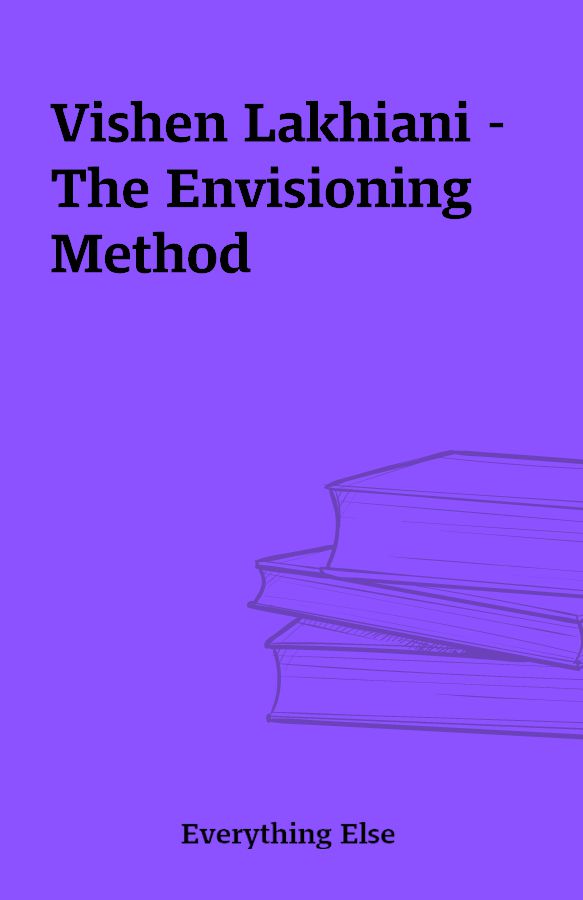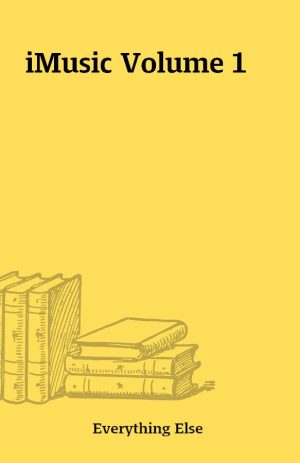Vishen Lakhiani – The Envisioning Method
Vishen Lakhiani – Envisioning Method All Materials Zip
[7 MP3s, 1 MP4, 1 PDF, 1 JPG]
Description
A 6 stage daily meditation practice with an introductory video, workbook and nice infographic. Really great to do every day… guaranteed to improve your life, happiness and general wellbeing!===IntroductionThe Envisioning Method is a transformative daily meditation program for beginners and novices alike. In this video, Vishen shares how meditation changed his life, and how after years of practice he combined 6 important aspects of the human being into a meditation practice that has the power to completely revolutionize your life for the better.The 6 Stages of The Envisioning MethodWhat is The Envisioning Method?It’s a process to get you in a state of flow. While you’re in this state of mind, you’ll actively be using your mind to envision various objects, feelings, and emotions that are all scientifically proven to create a tremendous beneficial effect on your body, mind, and emotions.There are 6 quick steps or phases – these will not take much of your time. Once you’re done, you’ll gain all that time back, multiplied in terms of productivity, creativity, and an elevated state of clarity and relaxation.How Important is Meditation?More and more entrepreneurs are claiming that their daily meditation practice is the single most important key factor in their overall success.The Envisioning Method is the precise process that I use to train entrepreneurs to achieve peak performance.Explained In One InfographicThe infographic below is based on the Envisioning Method. The 6 Phases in this meditation are a distillation of hundreds of books on personal growth and are designed to create the most remarkable transformation in your state of being — in the shortest amount of time.Let’s get started!Phase 1 – CompassionCompassion”Compassion is that which makes the heart of the good, move at the pain of others. It crushes and destroys the pain of others; thus, it is called compassion. It is called compassion because it shelters and embraces the distressed.” – BuddhaCompassion, a favorite practice of his holiness the Dalai Lama, is expressing the intention of moving from judgment to caring. From isolation to connection, and from indifference or dislike to understanding.Compassion, much like any other skill, is not fixed – it can be expanded and enhanced with training and practice.Scientific studies suggest not only emotional and spiritual benefits to compassion, but physical benefits as well. Compassion leads to an increase in the DHEA hormone which fights and counteracts the aging process while reducing cortisol, the “stress” hormone.Based on the neuroscience research of Richard J. Davidson, UW-Madison Professor of Psychology, “alterations in brain function were observed after just a total of 7 hours of training.”In her TED talk, American Zen Buddhist roshi, Joan Halifax, reveals that, “compassion enlivens us and enhances neural integration – hooking up all parts of the brain”.”This is my simple religion. There is no need for temples; no need for complicated philosophy. Our own brain, our own heart is our temple; the philosophy is kindness.” – Dalai LamaPhase 2 – GratitudeGratitudeWhat makes you happy? Is it family and friends? Wealth and success? Health and well-being? Or all of the above?Whatever it may be, philosophers and thought-leaders agree that happiness is a state of being which cannot be attained as an end in itself.Happiness comes from within and can be attained with the simple, yet powerful, act of gratitude.Gratitude is the acknowledgement and appreciation of the positive things that come our way that we did not actively work toward or ask for.Gratitude is not a mere emotional feeling or response, it is a choice we make. Meaning, we have the ability to capture the benefits by altering our own attitude of mind.Gratitude has the strongest link with mental well-being than any other character trait. Gratitude increases spiritualism, self-esteem, happiness, improves your sleep, and your energy levels.Gratitude even makes you more likely to exercise – according to an 11-week study of 96 Americans, those who kept a weekly journal exercised 40 minutes more per week than the control group. Other studies with the gratitude journal – writing one appreciative sentence for five things – just once a week, demonstrated significant effects. The group with the gratitude journal was more optimistic and felt happier.”Acknowledging the good that you already have in your life is the foundation for all abundance” — Eckhart TollePhase 3 – ForgivenessForgivenessForgiveness, at a minimum, is a decision to let go of the desire for revenge and ill-will toward the person who wronged you. It may also include feelings of goodwill toward the other person.Forgiveness is a skill you can improve. Granting forgiveness is more rewarding to you than the person you forgive. It is not excusing one’s past behavior or actions. It is a process which allows you to empower and thus free yourself of any burden or grudge weighing you down.Researchers have discovered mentally nursing a grudge has the same effects on the body as stressful events: tense muscles, blood pressure rises and sweating increases.Another study revealed a link between forgiving someone for a betrayal with improvements in blood pressure and heart rate, and a decreased workload for the heart.Forgiveness can also result in less pain and anxiety, as seen in a study where people with chronic back pain meditated, focusing on converting anger to compassion.Simply put, forgiveness puts the ball back in your court, giving YOU power and responsibility, rather than someone else, resulting in greater happiness.”The weak can never forgive. Forgiveness is an attribute of the strong.” —Mahatma GandhiPhase 4 – Envisioning the FutureEnvisioning the FutureCreative visualization is a powerful practice that literally allows you to change your outer-world by shifting and changing your thoughts and perceptions.Studies have shown that human beings overestimate what they can do in 1 year, and underestimate what they can do in 3 years. When doing creative visualization, it’s important to NOT think about what your life might look like based on where you are right now. I ask you not to be realistic here. Remember that realism is “nothing but a socially acceptable form of pessimism”.So do not be afraid to dream, desire, believe and achieve. Write down what appeals most to you and you are one step closer to making it real in your life.Is There Evidence for Visualization?Australian psychologist Alan Richardson conducted an experiment which revealed something astounding. He divided a group of basketball players into 3 smaller groups and tested their free-throw ability. The first group would practice 20 minutes every day. The second only visualized themselves making free throws, but no real practice was allowed. The final one would not practice or visualize at all.There was a significant improvement in the group that only visualized; they were almost as good as the group who actually practiced.Another example of visualization comes from the famous comedian and actor, Jim Carrey. Before his breakthrough success in Hollywood, Jim was a small-time comedian. In 1987, he wrote a check to himself for 10 million dollars. He dated it, “Thanksgiving 1995” and added the notation, “for acting services rendered.” He visualized it for years and in 1994 he received $10M for his role in Dumb and Dumber.”The biggest adventure you can take is to live the life of your dreams.” — Oprah WinfreyPhase 5 – Perfect DayPerfect DayIt’s not so much about what we do, but rather how we do anything. You see, a perfect day is cultivated by the quality of our being and our awareness in the present moment.The renowned neuropsychologist Daniel Siegel, coined the powerful phrase regarding the effect that our daily habits have on the synaptic connections in our brain: “What fires together, wires together.”Meaning the habits we form such as constantly checking email or social media, rushing through our morning routine or breakfast etc., carry on throughout our day.What results is a feeling of disconnection and a weakened ability to actually be fully present. This is because as these unhealthy habits become deeper and deeper ingrained in us, they rob us of our daily energy.Stephen Covey in the “7 Habits of Highly Effective People” paints this quality of character that we develop: “Our character is basically a composite of our habits. Because they are consistent, often unconscious patterns, they constantly, daily, express our character.” When you visualize your day, you take control of your path. It’s as though you decide and the universe – by some mysterious way – conspires to meet your demands.”The mind moves in the direction of our currently dominant thoughts.” — Earl NightingalePhase 6 – BlessingBlessingI learned about this exercise when meditating with monks for 9 days. Now, I can’t exactly explain what I saw or how it worked.But in those 9 days I witnessed some amazing things from these monks – people who went into states of ecstasy, moments of pure joy and intuition. They claimed it came from a higher power. Whether you believe in such a higher power or not is up to you. But often, “pretending” that we can call upon a higher power or an internal reservoir of energy to help us with our mission makes us feel more supported and confident in pursuing our dreams. This is where the Blessing Phase of this meditation comes in. Blessing or harnessing your internal energy is an act of affirmation and recognition, which is a spiritual or psychological practice.It is a process of recognition and awareness whereby we become aware of the goodness in others or ourselves.People like to be blessed. Even being acknowledged in a small way, is a powerful thing. And this is something you can do even toward yourself. Harnessing your internal energy makes you feel good.When we bless, we make note of the connection between ourselves and a greater spirit or energy, which can be anything we believe in.When we bless a person, we see them, admire them and wish them well. We make a direct connection with them and bring them into our sphere of consciousness. And that is why when you bless yourself or harness your own inner energy, you are able to reap all of these benefits.”We are shaped by our thoughts; we become what we think. When the mind is pure, joy follows like a shadow that never leaves.” — BuddhaThis is really great. I think it may even be available as a free course now, but I just re-found it on my computer and thought I would upload it here
You must be logged in to post a review.






Reviews
There are no reviews yet.